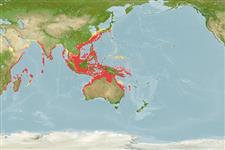Environment: milieu / climate zone / depth range / distribution range
นิเวศวิทยา
เกี่ยวกับทะเล,น้ำเค็ม สัตว์น้ำหน้าดิน; ระดับความลึก 10 - 155 m (Ref. 9824). Tropical; 37°N - 32°S, 35°E - 160°E
Indo-West Pacific: definitely recorded from Inhambane, Mozambique; throughout the Indian Ocean to Java, Sumatra, Viet Nam, Philippines, Taiwan, South Korea, Japan, and Lord Howe Island (Ref. 9824).
ขนาด / น้ำหนัก / Age
Maturity: Lm ? range ? - ? cm
Max length : 27.0 cm TL เพศผู้/กระเทย; (Ref. 9824)
เงี่ยงครีบหลัง (รวม) : 0; ก้านครีบอ่อนที่หาง (รวม) : 87 - 97; เงี่ยงครีบก้น: 0; ก้านครีบอ่อนที่ก้น: 61 - 73. Distinguished by cycloid scales on the ocular side, except for upper and lower margins of body, and a shorter lower jaw (2.3 to 2.9 times in head length). Body almost circular in shape in young, becoming ovate with growth.
Rare species (Ref. 9824). Found in sandy and muddy areas of the continental shelf (Ref. 5213). Feeds on benthic animals (Ref. 9824). Most sexually dimorphic characters develop at about 8 cm SL (Ref. 9824). Marketed fresh or used in making fish meal (Ref. 9824).
Life cycle and mating behavior
วัยเจริญพันธุ์ | การสืบพันธุ์ | การวางไข่ | เซลสืบพันธ์ของเพศเมีย(ไข่) | ความดกของไข่ | ตัวอ่อน
Hensley, D.A., 1986. Bothidae. p. 854-863. In M.M. Smith and P.C. Heemstra (eds.) Smiths' sea fishes. Springer-Verlag, Berlin. (Ref. 4417)
IUCN Red List Status (Ref. 130435: Version 2024-2)
Threat to humans
Harmless
Human uses
การประมง: การค้า
เครื่องมือ
Special reports
Download XML
แหล่งที่มาจากอินเตอร์เน็ต
Estimates based on models
Preferred temperature (Ref.
123201): 22.1 - 28.4, mean 27.1 °C (based on 860 cells).
Phylogenetic diversity index (Ref.
82804): PD
50 = 0.5000 [Uniqueness, from 0.5 = low to 2.0 = high].
Bayesian length-weight: a=0.01047 (0.00446 - 0.02457), b=3.04 (2.86 - 3.22), in cm total length, based on LWR estimates for this Genus-body shape (Ref.
93245).
ระดับชั้นอาหาร (Ref.
69278): 3.5 ±0.37 se; based on food items.
ความสามารถในการกลับคืนสู่ปกติ (Ref.
120179): ขนาดกลาง, เวลาต่ำสุดที่จะทำให้ประชากรเพิ่มขึ้นเป็น 2 เท่าใช้เวลา 1.4 - 4.4 ปี (Preliminary K or Fecundity.).
Fishing Vulnerability (Ref.
59153): Low vulnerability (17 of 100).
Nutrients (Ref.
124155): Calcium = 156 [73, 273] mg/100g; Iron = 0.971 [0.473, 1.736] mg/100g; Protein = 17.3 [15.9, 18.7] %; Omega3 = 0.143 [0.068, 0.285] g/100g; Selenium = 59 [29, 128] μg/100g; VitaminA = 20.1 [5.8, 71.0] μg/100g; Zinc = 1.08 [0.71, 1.57] mg/100g (wet weight);
